Turkey is a great country to explore, with a fascinating history and an amazing variety of natural landscapes to enjoy.
There is a very effective and well developed public transport system, with long distance buses operating in conjunction with a network of local “dolmus” services. These transport systems link up the entire country.
However, having the freedom and convenience of your own transport, whether you are on vacation or visiting on business, is a huge advantage.
Whether you want to rent a car in Turkey or plan on driving to Turkey with your own vehicle, we’ve got you covered!
In this guide we will discuss legal requirements, rules of the road, methods of driving, safety considerations, rental car procedures and also include some tips on how to make the most of your experience.

Disclaimer: Some links in this article are affiliate links, which means that if you purchase through them I receive a small commission, at no extra cost to you. This helps cover the cost of running this blog. Thanks for your support!
Quick Tips For Driving In Turkey
Before we get into the nitty gritty of rules and regulations, let’s start off with a few Turkish driving tips which we’ve picked up from living and driving in Turkey over the last 10 years. The roads in Turkey and the quality of the driving are generally good, however there are some points of difference and local habits which you will soon become accustomed to.
TRAFFIC LIGHTS
- Junctions in Turkey work pretty much the same as anywhere else in the world. Traffic lights are common and painfully slow. Turkish drivers do have a habit of jumping lights at times so be prepared. It’s best not to join in on this as the police won’t be quite so friendly if you are caught!
- When a light changes from green to red it may flash for a short time first, to warn you of its imminent change. This is quite useful but be aware that the car behind you might see this as a reason to speed up before the light changes.
- When waiting at a red light, as soon as it turns green the car or cars behind you will usually hoot their horn to let you know. Don’t let this stress you out it’s pretty normal and it’s because drivers in Turkey often stop beyond the view of the light. Be careful not to stop too close to the junction so you don’t have this problem yourself.
HIGHWAYS
- As with many countries where you get merging traffic or cars joining a road, they will often try to push in. As a rule of thumb it helps to make eye contact with the driver. Basically if he’s deliberately ignoring you, he’s going to go for it whether there’s room or not!
- On highways there is often a shoulder to the road. Trucks and slow moving local traffic will often move over into this lane to allow faster traffic to overtake. Be careful here as it doesn’t necessarily mean it’s safe and also they may inadvertently spray you with loose stones and rocks that lie by the side of the road. (Thats why Windscreen and headlight insurance might be a good choice when hiring a car!)
- Highway roads are generally in great condition but as you branch off onto the dual carriageways and rural roads the quality starts to dip. On rural roads be aware of potholes, loose gravel and watch out for chickens, goats and slow moving tractors.
- Be careful with 3 lane roads ie. a road with a lane down the middle for either carriageway to use whilst overtaking. The use of this lane is indicated by white lines on the road. Just be aware that not everyone will abide by the rules here so it can get pretty exciting. Take care, especially on the bends.
TRAFFIC & VEHICLES
- Traffic in most of Turkey is generally light until you enter a city, in which case it’s quite often gridlock. For example, the great Turkish city of Istanbul is particularly congested. The best advise would be to avoid rush hour. Plan your route carefully as a wrong turn could cost you hours. And don’t forget to be really patient – people can get a little pushy.
- There are quite a lot of older vehicles on the roads in Turkey. Some might call them classics, but the reality is that some of these old gems are unlikely to be at the level of safety to a modern motor, especially when it comes down to brakes and indicators. Don’t assume they always work as they should.
- On the subject of indicators, even if they work, they may not always be used. Mostly they’re not!
Above all expect the unexpected, enjoy the experience and drive carefully!
If you’re enjoying this content consider giving me a follow on social media
Driving In Turkey Requirements: Visas and Licenses
VISAS
In order to visit all the beautiful places in Turkey you may need a visa. Tourists can enter Turkey for a period of 90 days, spread over a 180 day period. Some nationals are able to enter visa free but others will require a visa which is normally an e-visa.
Here’s the link for information on e-visas:
For information regarding all visas for Turkey, here’s the link:
LICENSES
In order to drive in Turkey, whether it’s a hire car or your own vehicle, a driving license is required. Turkey accepts driving licenses from most countries for a period of up to 6 months, after which you are required to obtain a Turkish license. In most cases a test is not required to achieve this.
Driving in Turkey as a tourist requires an International Driving Permit. These can be obtained online or from driving authorities worldwide. (For example UK permits can be obtained simply and cheaply in many Post offices)
An international Driving permit simply acts as a translation of your licence, so is used in conjunction with, rather than in place of your national driving license. It is important to obtain the correct IDP that is valid for Turkey. (In the UK it’s permit 1968)
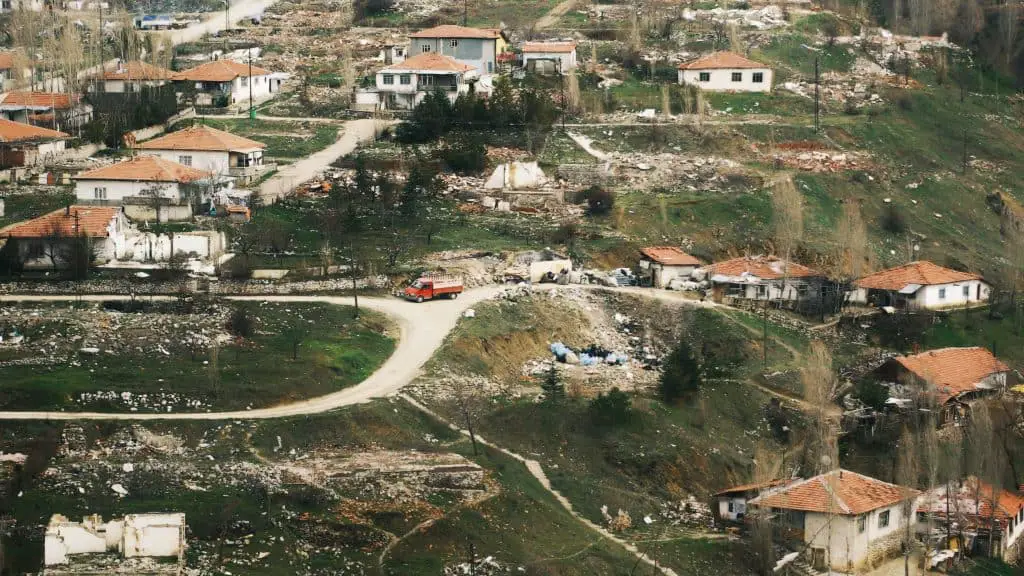
Related Reading
Rules Of The Road In Turkey
It is important when driving overseas to understand the rules of the road at your chosen destination. Whilst most countries adopt very similar rules and signs, there are always a few differences which you should make yourself aware of.
Here are some of the important rules that you need to consider when driving in Turkey as a tourist:
- Drive on the right side of the road.
- Give way to traffic coming from the left.
- Traffic on roundabouts have right of way, the same as Europe. However, be careful of highway junctions which have the appearance of roundabouts. This type of roundabout prioritises the highway traffic, rather than the traffic on the roundabout. In this case follow the signs, road markings and traffic lights if present.
- Traffic lights are common place and operate in the usual way. It’s common for a green light to flash for a short period of time to warn approaching motorists that it is about to change.
- There is a zero blood alcohol limit in Turkey.
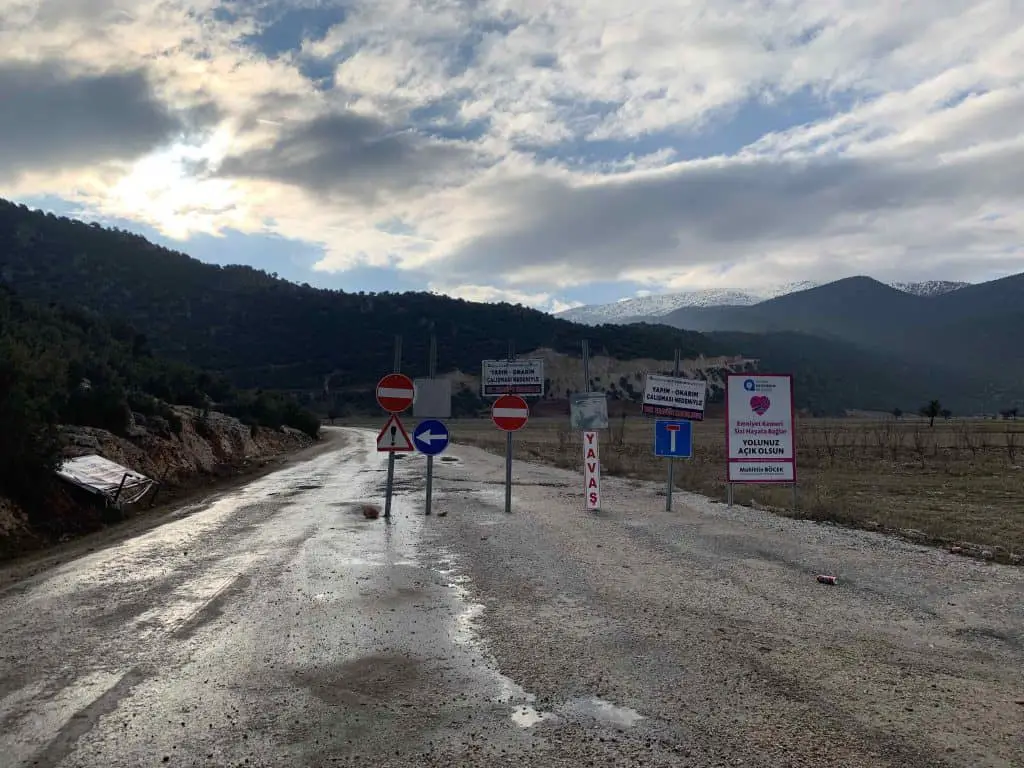
Turkish Speed Limits
The official speed limits for driving a car in Turkey are as follows:
- Urban area – 50 KMH
- Highway/Dual Carriageways – 90 KMH
- Motorway/Expressway – 120 KMH.
There are also lots of random limits which are indicated by signs. Often a 70KMH limit will be observed but these only seem to last for a brief time. On dual carriageways you will notice the speed limit drops to 50KMH as you approach a junction and then it promptly returns to 90KMH. Very few locals observe this rule!
Urban areas, particularly on rural roads, begin where you observe the sign showing the town or village name and continue until you see the same sign with a diagonal line through it, indicating the end of the village. You will often find a speed limit sign where pedestrians might cross and specific warnings as you would expect close to schools.
Speed limits are controlled either by the use of speed cameras or radar. It is common to find traffic police out and about on weekends. They will often remind you of this by using triangular warning signs with RADAR printed on them. At junctions you will find speed cameras on the overhead gantries.
The speed cameras will send the fine directly to your rental company who will pass the cost onto you. If you are caught speeding (or any other misdemeanour) there is an on the spot fine, which increases with the severity of the offence. The police, although usually polite, can be quite strict when it comes to speeding so be aware and take it easy.
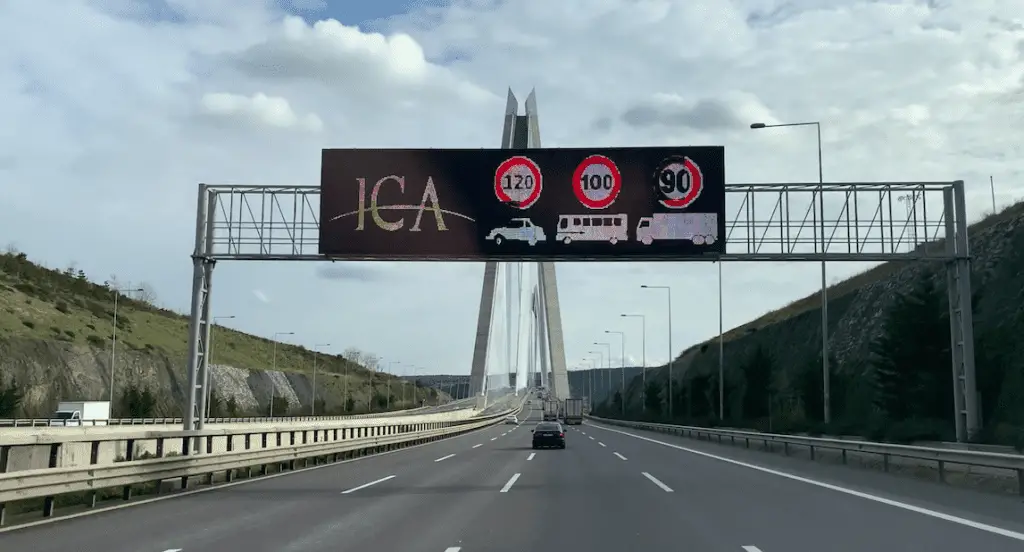
Police Check Points
It is quite common to find police check points in Turkey. These can be anywhere but especially close to sensitive borders and military zones. They might be manned by the Jandarma, Traffic Polis or even the military, who often carry guns.
Don’t panic as these guys are generally very polite especially to Tourists. Its an opprtunity to practice your newly learned Turkish phrases and they will most likely wave you straight through. They generally confirm you’re wearing a seatbelt and may want to check your documents are all in order.
Emergencies
Dial 112 for all Emergency services in Turkey.
Renting A Car In Turkey
Turkey has a highly evolved infrastructure to support both tourism and business travel alike. Hiring a car is as easy, if not easier, than it is in Europe.
To rent a car in Turkey you need to be over 21yrs old. The cost will vary considerably from city to city and depend on the time of year. Out of season you can pay as little as 10Euros per day but in peak season expect to pay around 30Euros.
Most of the big multinational hire car companies are represented at the main international airports, as well as some very good local operators. The well known multinationals offer good service as you would expect, in line with the standards that you receive in Europe.
If you want to save on price then rent your car in advance. The best rental company for Turkey is LocalRent. They compare all the top operators to find the best deal and provide a quality service. They specialise in rental cars in this region.
Turkish hire companies may be a bit of a mixed bag but generally offer very good, hospitable service and often at a more agreeable price. Just check the reviews and understand exactly what you get for the money, especially with regards to insurance. All hire companies will try to up-sell additional insurance services and it is advisable to factor this cost in when making your purchase. It is possible to purchase excess insurance before you arrive in Turkey which will be much cheaper than buying it on arrival.
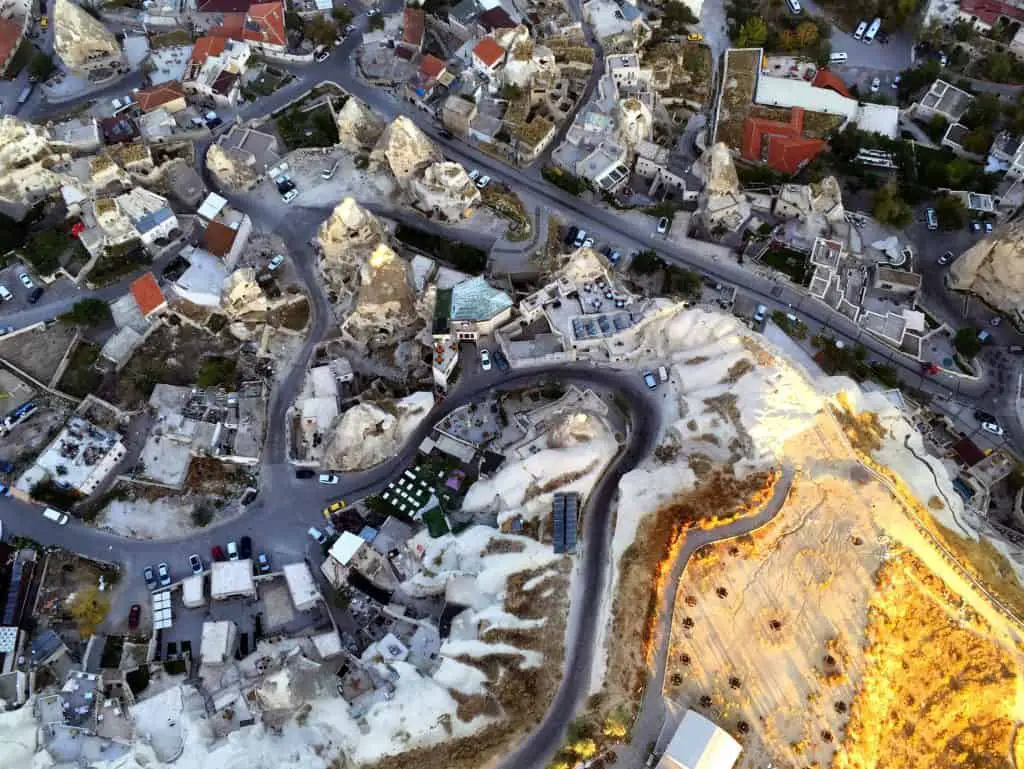
All sorts of vehicle are available for rent including 4×4’s and there are companies specialising in the hire of campervans and motorhomes.
When renting vehicles from regional international airports in Turkey, you are often met at the exit of the terminal and your car may be waiting for you in the airport carpark, which is hugely convenient. Be aware, you may be expected to pay for the parking, so have some local currency available before you leave the airport.
The paperwork is normally very straight forward and you will have to provide credit card details for a deposit of some sort and to cover tolls and fines. You will also need to provide ID such as a passport.
Cars tend to be of a good standard but it’s advisable to check them over on collection, especially tyres and lights. They should also come supplied with safety equipment such as a first aid kit, warning triangle and spare bulbs.
Rental cars tend to come completely empty of fuel so make sure you have the means to find and buy fuel at the first opportunity.
Turkey’s Road Toll System
Motorways in Turkey incur a toll fee. These are either collected at toll booths or by using an automated system by way of an electronic tag which is stuck to the car windscreen. All other roads are toll free.
If you are renting a car in Turkey, the hire company may instruct you to pass through the OGS or HGS lanes at the toll gates, in which case you will then pay the hire company for the toll. Simply slow down and drive through the toll gate and the electronic tag in your rental car will be scanned.
If you have your own vehicle then you will need to register you vehicle for the HGS collection method. (High-Speed Toll System or Hızlı Geçiş Sistem). This can be obtained at the land borders or in the office at the first motorway toll you come to.
You will be given an electronic tag sticker with a bar code, to stick on your windscreen. This needs to go near the top and centre of the windscreen.
As a foreigner you will need to pre-charge your HGS with sufficient funds for your intended journey. Don’t panic if you run out as you can also top up your account and pay for any unpaid tolls at most Post Offices (PPT) and branches of Zirat Bank. These are found all over Turkey.
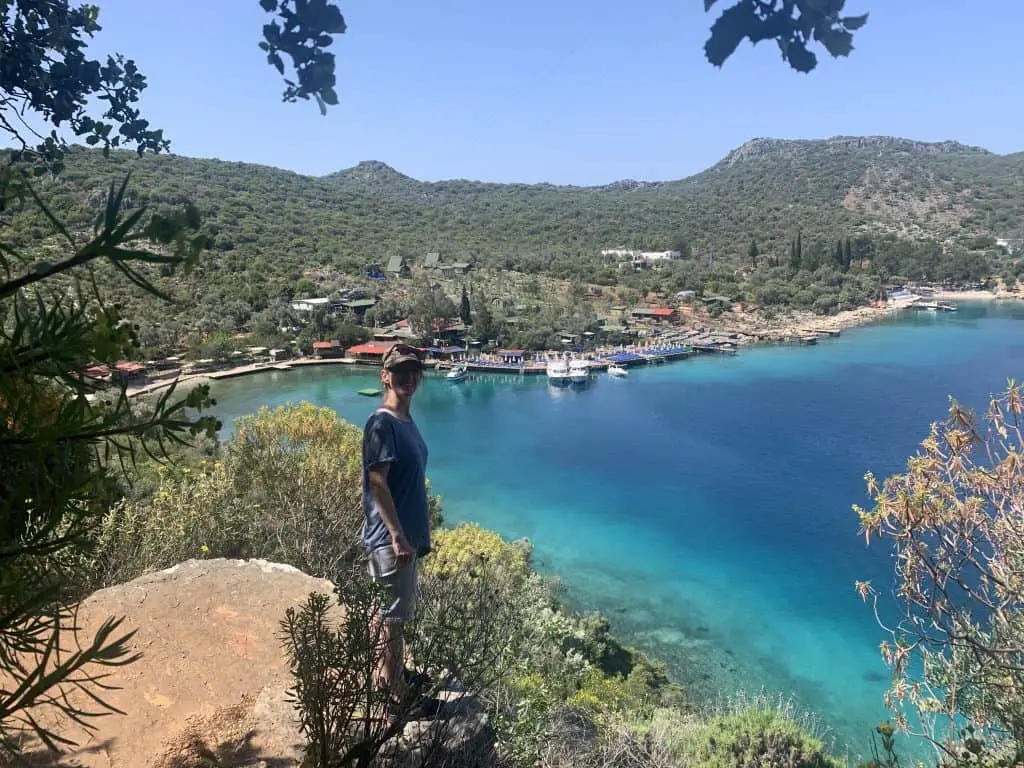
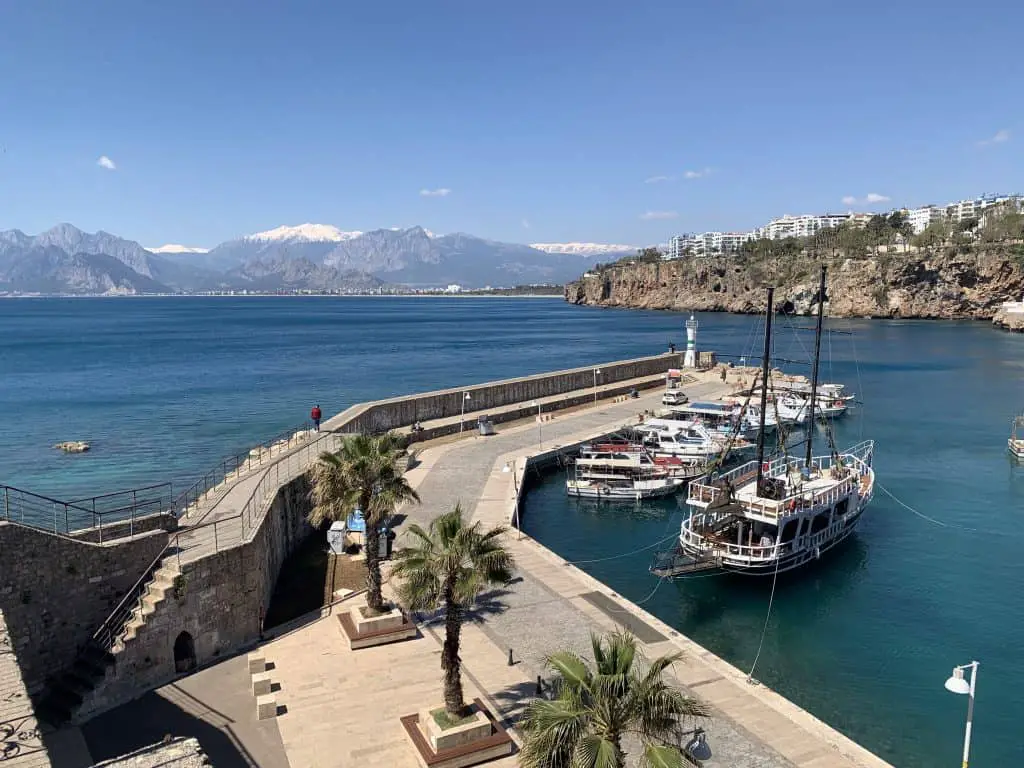
Tolls have gone up in price recently and are especially expensive for the motorway bridges around Istanbul. However, the motorways themselves are all of a very high standard and a great way to get around the country fast.
If entering Turkey from Europe, the motorway heads directly into Istanbul and beyond. If you are not planning to visit Istanbul and are heading for the Mediterranean coast, I suggest heading to Eceabat and taking the ferry to Çanakkale. This will save quite a lot of money on tolls and is generally a more scenic route.
This route passes through the Galipoli peninsula, Troy, Ephesus and Mediterranean towns like, Fethiye, Oludeniz, Kaş and Antalya before carrying on to Cappadocia.
Read more about taking a road trip from Istanbul to Cappadocia in this guide.
Fuel In Turkey
The cost of fuel fluctuates a lot in Turkey. A number of years ago it was up over $2 per litre. In 2022 it dropped to under $1 per litre , it can all depend on the exchange rate of the day.
Benzin is Petrol and Motorin is Diesel. most service stations sell Euro dizel these days which is the highest quality of diesel and most hire car companies specify this. LPG is also widely available, which is very handy for campervans and motorhomes who use LPG for cooking.
Fuel stations are found regularly, so you’ll never be in too much danger of running low on fuel. Pump attendants are still employed in Turkey so there’s no need to get your hands dirty. It’s not compulsory to tip the attendants but you can if you’d like.
Also, modern fuel stations serve some pretty epic Turkish cuisine so don’t be afraid to enjoy a meal or two along the journey.

Seasonal Considerations When Driving In Turkey
Turkey is blessed with a typically mediterranean climate but it very much has four seasons per year.
Summers tend to be very hot. Winters can be anywhere between really mild on the Mediterranean coast, to seriously cold as you head further north, east and up into the mountainous areas. Spring and Autumn are a pleasant temperature but can be wet at times.
In Summer most hire cars will come with air conditioning and if you plan on bringing your own vehicle to Turkey, this would definitely be worth a consideration. Your vehicle will also need a very effective cooling system to cope with temperatures in excess of 40 degrees C.
In Winter it can get mighty cold. It is advisable to carry snow chains and consider fitting winter or all season tyres as you would need for driving in much of Europe. Make sure you have good antifreeze as it can get down to -20 in parts.
Mountain roads are cleared during periods of snowfall but road gritting, especially in the more rural areas, is less likely to be carried out. So be extremely watchful for ice in Winter, especially on rural, mountainous roads.
Much of Turkey gets over 300 days of sunshine per year but when it rains, it pours and big storms can rage on for days. This can cause localised flooding and snow blocked roads in Winter.
Aquaplaning is a potential risk, along with very poor visibility, especially on rural roads which are unlit and often have poor road markings. Care is needed at all times in harsh weather. Also in extreme weather road surfaces can melt leading to slippery and uneven sections. Be aware of loose stone chippings as these can snmash headlights and windscreens. Getting excess insurance is a good idea.
Driving Your Own Vehicle In Turkey
It is relatively straight forward to drive your own vehicle in Turkey. Whether a car, campervan or motorhome (described as a caravan in Turkey), here are the key requirements:
- Safety equipment.(legal requirement This will be the same as for Europe ie. Warning triangle, first aid kit, high visibility jacket, spare bulbs. For a winter, trip snow chains might be advisable. Click image for more.
- Sticker denoting where your vehicle is from eg UK, D,F, NL etc.
- Driving License valid for use in Turkey (see above)
- Documents for vehicle (eg. For UK registered vehicle this would be your V5 document)
- Insurance.
- ESSENTIAL items for safe and enjoyable driving in Europe
- FOR EMERGENCIES first aid kit, warning triangle, hi-vis vest, bulb kit
- FOR SAFETY headlight beam benders and a UK plate
- FOR CONVENIENCE maps and the AA European Driver’s Handbook
- AA BRAND products in a compact and convenient kit with zipped storage bag
Car Insurance
Many UK and EU vehicle policies may include cover in Turkey but only for the European part ie only up to the west (European) part of Istanbul. Be sure to check and inform your insurance company of all your plans before departure. Beyond this a Turkey wide policy will be required and is available to buy at the border.
On entry to Turkey you will be asked to show a Green Card as proof of this cover. (Your actual policy details will not be sufficient and for UK policies Green Cards are generally no longer issued as standard)
On entry you will be directed to the Insurance Office where you can purchase 3rd party insurance that covers your vehicle for all of Turkey, for the duration of your stay. You will need to buy this cover before completing entry formalities.
Your Insurance Company should be able to offer insurance cover for all of Turkey but it may be very expensive and the border officials may still insist that you obtain the Turkish insurance.
The insurance cover offered at the border will typically be 3rd party insurance, as this is the minimum required by law in Turkey. The cost of this insurance will depend on the type of vehicle and the duration of the cover. (The price is reasonable at just under $100 for a “Caravan” for 3 months).
If you wish to purchase fully comprehensive insurance in Turkey there are insurance companies online (with websites in English) offering policies that cover both the legally required 3rd party insurance and a fully comprehensive policy, which can be purchased together in advance of your visit.
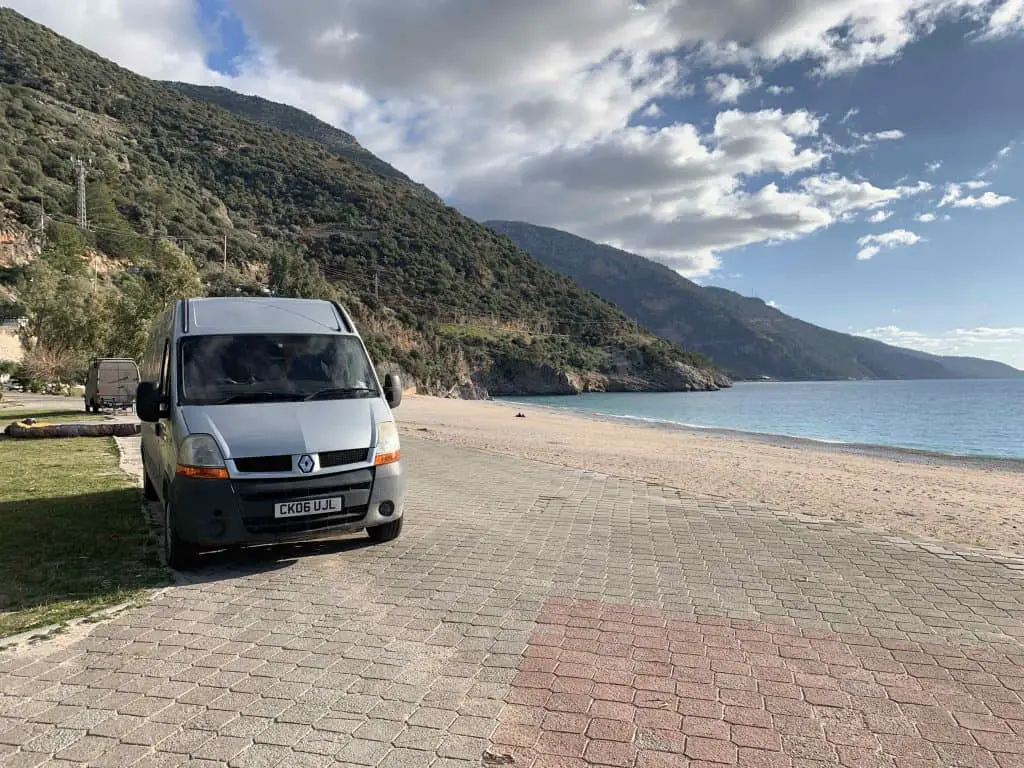
The Border Crossing: Driving To Turkey From Europe
After exiting the country you are entering from, you arrive at the first barrier. Sometimes this will be open and unmanned, in which case drive slowly through. If manned there may be a quick check of paperwork and you may be issued a border card, which you will need to show at every stage of the crossing.
The main border will be next and once you reach the window you will most likely be sent to the Insurance Office and Ministry of Interiors Office for insurance and then to complete Customs clearance for your vehicle. They will more than likely they will want to x-ray the vehicle if you have a campervan.
This all sounds like a bit of a nuisance, which it is, however the officials are usually very polite, helpful and hospitable.
Arriving at the border late at night may be beneficial as the border will be less busy. It will also have less staff on duty although this doesn’t mean they are less likely to search your vehicle. Expect the customs officers to be quite thorough, so be patient keep smiling and do what they ask. It’s rare that the search takes very long.
If, or from my experience, when they x-ray the vehicle, they may ask you to empty all the luggage first and scan your luggage separately. For this reason, it’s probably best not arrive at noon on a hot day!
Once searched and passports stamped you proceed to the next barrier. This is usually a quick check to make sure your paperwork has all been completed correctly and you are on your way.
I’m sure you will hear all sorts of horror stories about Turkish border crossings, but generally they are well organised, polite and you are usually through within 2 hours. Occasionally, though, you might come across an official who takes his/her job a bit more seriously than you might have hoped for.
Patience and politeness is key.
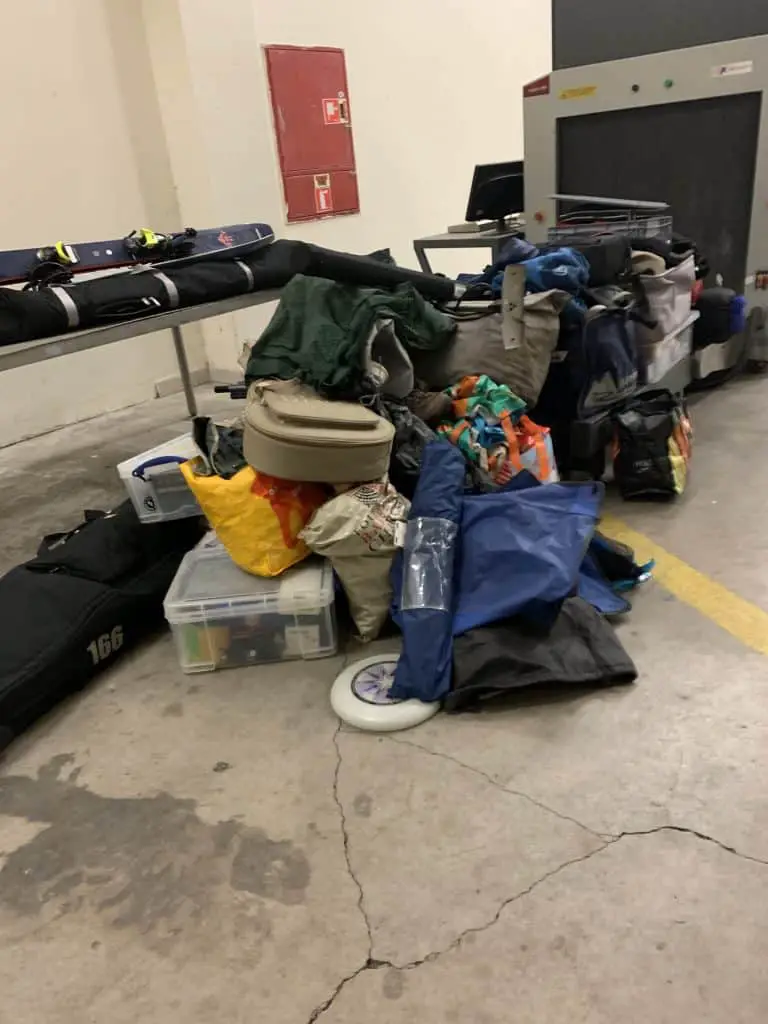
Breaking Down In Turkey
It is possible to get breakdown cover for Turkey but if bought in the UK or Europe, may well be a huge expense.
Having a little mechanical knowledge and a few tools might be useful here, but Turkey is full of highly skilled mechanics (and some not so highly skilled too!). Finding a decent workshop is key.
Breaking down in Turkey might sound like your worst nightmare but it could also be the beginning of a different kind of adventure.
Getting recovered will be the most stressful part and this will require asking the locals for help, so you will soon learn the Turkish work for help and recovery truck etc. Thank goodness for Google Translate! Don’t panic though because people in Turkey are always willing to help, especially if you are in a bit of bother.
If your vehicle can still be driven a little way it is relatively easy to get your vehicle fixed.
All cities and towns have industrial areas with multiple workshops specialised in fixing everything. These places will be signposted “Saniye” and once you find this area, simply look for a workshop specialising in your vehicle make or ask someone to point you in the right direction. If in doubt just enter “workshop” into Google maps and you should find a starting point to a solution.
Spare parts in Turkey are generally cheaper than in the UK or Europe, depending on the make of vehicle. Unless you go to a main dealer in Istanbul, you won’t be paying a crazy price.
On our most recent travels in Turkey we broke down….. twice! On the first breakdown near Bursa, a diagnostics check with a laptop found a loose connection which cost £6 ($10) and was promptly fixed, even though it was 9.30pm. Afterwards my only regret was that I hadn’t offered him extra.
The second issue was fixed in Fethiye. It required 2 hours, with 2 mechanics and several young helpers. With spare parts the fix came to a total of £30 ($45). We met some super nice guys and drank loads of tea (çay) in the process.
So it was actually nice to get an experience of normal life in Turkey and meet some friendly local people!
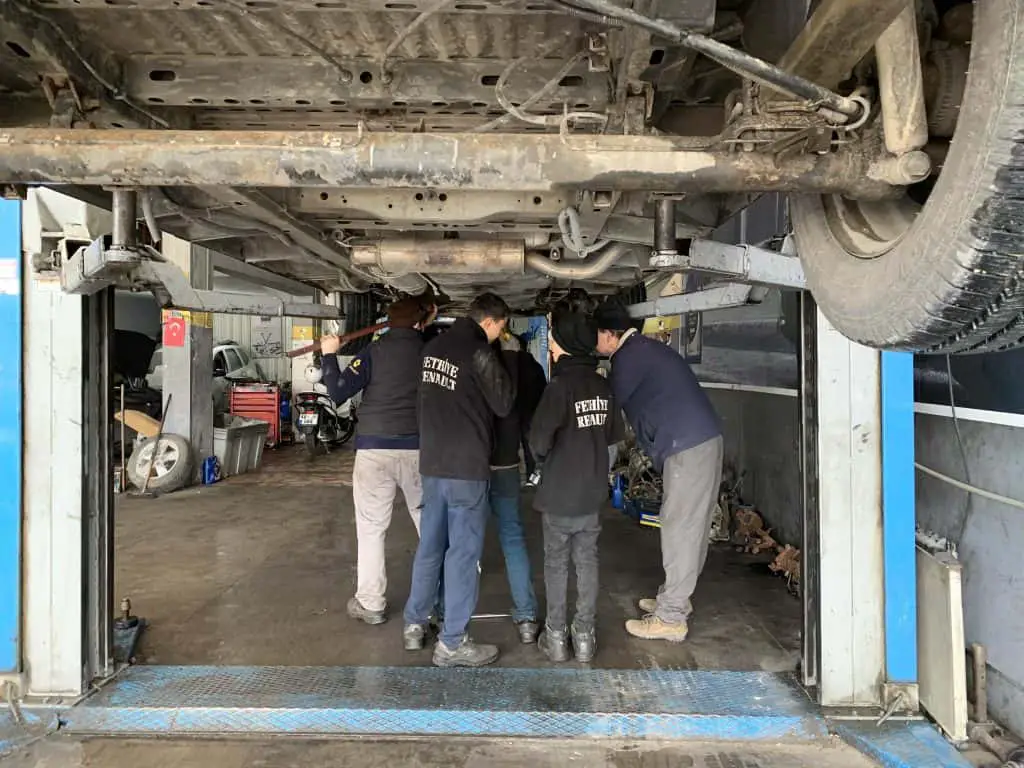
Turkey Driving Summary
Turkey might sounds pretty exotic and it certainly is when it comes to its history and landscapes. However, when it comes to driving in Turkey there’s very little to worry about. The roads are generally good and even when they are not they are still acceptable. The standard of driving is pretty decent, although it pays to be vigilant and expect the unexpected at times.
Car rental is easy and relatively cheap, although bringing your own vehicle into Turkey is straight forward. Fuel is cheap compared to Europe and it’s easy to find a mechanic to fix your car even if you break down. If you rent a car, help is just a phone call away.
For the adventurous it is possible to get off the beaten track in Turkey and find some truely amazing and remote places. For the really adventurous there are even some dirt roads to be found in the high mountains. Everywhere yo go the Turks are super friendly and hospitable.
Be prepared for some long days at the wheel. For example Istanbul to Cappadocia might take up to 9 hours and Istanbul to Antalya will be about 10 hours. But the scenery is always varied and often stunning.
So, plan your trip. Allow for stopovers. Take your time and enjoy this beautiful country.
Related reading
Continuing your driving tour onwards from Turkey? You might enjoy the following guides!
Don’t forget to get travel insurance before you set off
Join My Newsletter Today


